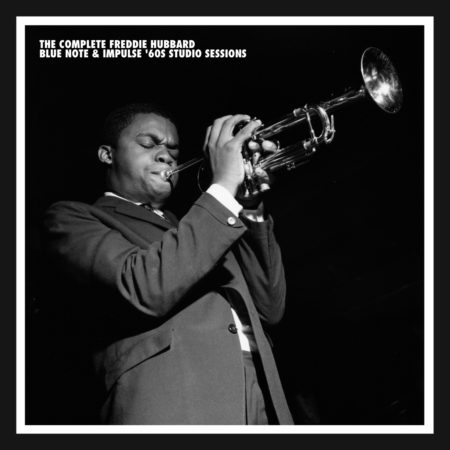 The comes a point in certain artists where they not only master a certain style of their art, but simply embody it. During the 1950s and 60s, Freddie Hubbard was the living image and sound of what a hard bop trumpeter was to be. Big, bold, brassy, adventurous and relentlessly swinging with virtuosity, he was the cock of the walk of trumpet players. He was a sideman for Art Blakey’s Jazz Messengers, teamed with John Coltrane and Dexter Gordon and even went toe to toe with Ornette Coleman-he did it all, and he did it all seemingly effortlessly.
The comes a point in certain artists where they not only master a certain style of their art, but simply embody it. During the 1950s and 60s, Freddie Hubbard was the living image and sound of what a hard bop trumpeter was to be. Big, bold, brassy, adventurous and relentlessly swinging with virtuosity, he was the cock of the walk of trumpet players. He was a sideman for Art Blakey’s Jazz Messengers, teamed with John Coltrane and Dexter Gordon and even went toe to toe with Ornette Coleman-he did it all, and he did it all seemingly effortlessly.
This seven disc, limited edition of 5000 boxes have him during his halcyon days at Blue Note and Impulse Records. This mix of energy, machismo and beauty set the standard for modern jazz trumpet. Sure, you can buy a bunch of them individually, but sooner later you’re going to want them all. Maybe not today, maybe not tomorrow, but some day. Here’s looking at you, kid.
His catalogue at Blue Note is legendary. He hit the ground running as a leader in 1960 with Open Sesame with McCoy Tyner/p, Tina Brooks/ts, Clifford Jarvis/dr and Sam Jones/b a quicksilver “All Or Nothing At All” and fluffy ballad “But Beautiful”. The same year brought his second release with Tyner, Paul Chambers/b, Philly Joe Jones/dr and Hank Mobley/ts delving into fellow trumpeter Kenny Dorham’s book with “Asiatic Raes” and “Karioka” while “I Wish I Knew” glistens.
Next year brought out Hub Cap with Julian Priester/tb, Jimmy Heath/ts, Cedar Walton/p, Larry Ridley/b and Philly Joe Jones/dr with the snazzy title tune and cleverly arranged “Plexus”. In 1962 Hubbard starts getting a bit adventurous and feisty, bringing in alto saxist and flutist James Spaulding, Herbie Hancock/p, Reggie Workman/b and Clifford Jarvis/dr for a left of center “You’re My Everything”, the frisky “Hub-Tones” and oblique “Lament For Booker’. The same year he point out one of his true classics, Ready for Freddie with part of John Coltrane’s team of Art Davis/b, Elvin Jones/dr and McCoy Tyner/p along with tenor saxist Wayne Shorter, producing two timeless pieces, the swinging “Birdlike” and the intense “Crisis” with Hubbard blowing bubbles on “Weaver Of Dreams”.
Hubbard then took his trumpet to a new plateau with the bordering on the avant-garde with Breaking Point, his first album away from Art Blakey in 1964, and Hubbard’s horn bursting at the seams with Joe Chambers/dr, Eddie Khan/b, Ronnie Matthews/p and James Spaulding/fl-as on ground breaking pieces like the fiery “Blue Frenzy” and “Mirrors”. This one still sounds ahead of its time. Hubbard’s last Blue Note session in 1966 has him in a larger ensemble including Joe Henderson-Hank Mobley/ts, McCoy Tyner-Harold Mabern-Herbie Hancock/p, Larry Ridley-Bob Cranshaw-Reggie Workman/b, Clifford Jarvis-Pet La Roca-Elvin Jones/dr, and even some congas and a one-off bassoon for visceral pieces like “Conga Black” and “Soul Surge”. Hubbard still sounds in control and adventurous in this album of uncharted waters.
His work on Impulse! records dates back actually to 1962 with The Artistry of Freddie Hubbard along with mainstreamers Curtis Fuller/tb, John Gilmore/ts-tb, Tommy Flanagan/p, Art Davis/b and Louis Hayes/dr. The team is riveting on the driving read of “Caravan” with Hubbard body surfing on the 6 foot wave of “The 7th Day”. Hubbard got even more ambitious for his next album. At 25, his The Body & The Soul in 1963 is a mature work, including arrangements for a septet, a 16 member big band and even a string orchestra conducted by Wayne Shorter no less. There are intriguing reads of the delicate “Dedicated To You” as well as a samba’d “Mana de Carnaval” with some French Horn, with “Aries” featuring Hubbard in a muscle flexing mood.
This last session completed an important phase of Freddie Hubbard’s musical journey. It was not to be the end of his pilgrimage, as he then ventured to other world’s with the gauntlet of Red Clay, just a few years later. But these are the albums that you want to hear in order to understand the evolution of the jazz trumpet, as during these years, The Hub was at the top of the hill.